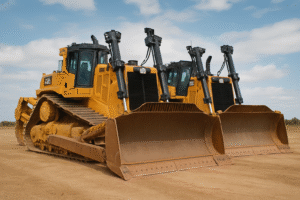Many property developers have tried to take on a specialised asset class, such as a Retirement Village (or worse, an Aged Care Facility), only to find themselves up against apparently insurmountable challenges getting the project out of the ground, after having spent a significant amount of time and expense getting the Council to approve the development application.
Never one to shy away from challenges, in this case, we had two significant hurdles to jump over:
- The developer would be a first-time owner-operator of the Greenfield Retirement Village; and
- He was a builder-developer (also known as an owner-builder).
At STAC Capital, we don’t shy away from challenging situations. When faced with such a scenario, we take the time to understand the client and their project or business, the challenges they’re facing so that we can work out how to tailor a strategic financing solution.
Don’t Confuse Retirement Villages with…
With an ageing population going full-speed ahead thanks to most Baby-Boomers now either being retired or very close to, many developers have seen an opportunity to provide “downsizing” housing solutions.
There is a lot of misunderstanding by people outside the Retirement Villages and Aged Care sectors. To be clear, they are VERY different. Add to that what’s often known as “Over 55’s” (often called communities, villages or resorts).
Do not confuse any of these with another, as they are all very different for reasons that are not necessarily obvious to the beginner. I could carry on for pages about the differences (and a specialist lawyer could write a novel!), but here’s an “Old-Folks-Homes 101” class in a few dot points:
- Aged Care – is very highly regulated at the Commonwealth/Federal Government level. Most are more like a hospital than an apartment building, with a lot of nurses on staff 24/7. The revenue model is complicated to say the least, so much so that it would deserve its own article even to do a high-level explanation, so I’ll leave it out of here. A scary percentage (more than half) of the sector runs a loss, and because of this, a large portion of the industry is owned by Not-for-Profits (particularly church-owned).
- Retirement Villages – regulated under state-based legislation, so whilst the product looks the same across the country, there are varying legal technicalities from state to state. Most RVs have a Deferred Management Fee (DMF) model, wherein the operator keeps a percentage of the sale proceeds (usually up to about 35%) when the resident leaves – which is the big [often the only] revenue earner for the operator.
- Over 55’s – also state-based legislation, but completely different legislation to RVs. Originally began life as an affordable product, wherein the resident would buy a caravan-without-wheels and then rent the land from the operator, but it has now progressed to often very large luxury homes that bare no resemblance to anything demountable in beautiful communities with unbelievable resort features.
If you’re a property developer that’s thinking about getting into any of these sectors, suffice to say that Over 55’s are by far the easiest to develop and finance, whilst Aged Care is by far the most difficult (and dare I say near impossible if you’re not already in the industry, unless you have an operator ready to do a JV with you).
Challenges with Financing Retirement Village
Whilst some developers have gone the easier route of focusing on luxury apartments as a solution to the downsizer demand, some braver developers have looked to the Retirement Village (“RV”) model.
Whilst there can be great opportunities in the RV sector, expanding a little on the points above, it has numerous quirks that create some significant challenges for those without experience in the sector. In particular, these include:
Pre-Sales aren’t binding.
This is a really big biggie. Banks want pre-sales, but RV legislation is so heavily in favour of the consumer that they can sign your Contract and pay their deposit – and yet they can move their furniture in months later when you’ve finished, then say “actually, I don’t really like this, give me my money back”. Yep, seriously.
Community Facilities aren’t cheap.
When Betty & Bob are comparing an RV to a normal apartment or townhouse, the community facilities are a big part of the attraction. These chew up a lot of land and the expectations of features are usually reasonably high – pools, BBQs and gyms like normal residential projects, but add to that bowls greens or tennis courts, large community centres for get-togethers of 100+ people at a time, multiple smaller function rooms, as well as a commercial kitchen.
On top of the expense, they often need to be developed in stage 1, which also inherently carries the heavy earthworks and civils costs – so stage 1 is rarely profitable (if not heavily loss-making).
Development Profit
If the above comments didn’t already scare you, the reality is that most RVs don’t show any development profit, at all. On top of the community facilities, you can’t pack the oldies in as tightly as you might with a normal residential development. Larger bathrooms, expectations of more living space, storage space for the downsizers that don’t want to throw out a long lifetime’s worth of stuff.
It can be possible to design an RV project that does deliver a profit margin comparable to a residential project – but just be aware that it’s not easy to do so.
Who’s going to setup and run the business?
The operations aren’t as easy to put together as it might seem. There is a lot of specialist experience that is required, a mountain of red tape. This is a factor that gets a huge amount of attention from lenders, particularly the banks; so much so that the banks will rarely consider financing a new entrant.
DMF revenue – be prepared to Wait…
The potential revenues from DMFs can be very attractive – most RVs progressively increase to max out at about 35% of the buy-in price by year 6 or 7 (e.g. if the buy-in was $500k, then the operator keeps $175,000 when the resident leaves). On top of that, many operators keep 50-100% of capital gains, as well as an amount for refurbishment costs before putting in the next resident.
A mature RV that has been operating for a long time, with residents that moved in at all different times, will have a pretty constant stream of DMF revenues.
HOWEVER, the big cash-flow challenge with a brand-new RV development is that you naturally want to fill it up with new residents as quickly as possible – which in turn means that you’re likely to have quite a number of years before you start getting many leave. It is therefore generally accepted that you’ll not likely see much DMF revenue until you get to about year 6 or 7 – which means that your RV business will break-even at best; forget about making profit until then. That’s a long time to wait for most.
How we Financed a Retirement Village development
If we haven’t already made it obvious, RVs are much more difficult to get going than residential developments – and the financing is no different.
Having said that, it’s not impossible.
We have successfully negotiated a finance structure for a new-to-sector Retirement Village developer & operator.
Rather than providing a simple finance brokerage service, we initially started with a full Advisory scope, to assist the developer getting all of the above bases covered properly. In the early stages of the project planning, this included STAC bringing in a number of key experts to be part of the project team, including:
- Lawyers with specialist RV legislation experience
- Lawyers for corporate structuring & tax advice (noting there is a lot of non-standard complexity in RVs, particularly regarding GST)
- Marketing & Sales team that specialise in RVs (a very different game versus residential sales)
- Architects – again, those with RV experience
- Operations experts to setup the business and manage all the red tape
The debt market for RVs is most definitely very tight; there are not countless options out there. Not all of the banks are active, whilst those that are, do so very conservatively.
Adding in this client’s lack of experience in the retirement village sector, combined with being a builder-developer, only added more challenges.
Notwithstanding the headwinds, STAC were able to negotiate a structured financing package, made up of:
- Non-Bank Senior Debt at a 65% LVR on GRV and Balance Land (for future stages); plus
- Mezzanine Debt to a total LVR of 75%.
Combining senior and mezzanine debt structures is always a complex process (amplified by one of our favourite sayings “the deal’s always done ’til the lawyers get involved”!) and requires a thorough understanding of process, requirements and negotiation skills.
At STAC Capital, we have the expertise and experience to navigate these complexities to create a financing package that maximises value for our clients.
Challenges Don’t Scare STAC
Whether you’re a builder-developer and/or a first-time owner-operator looking to enter the retirement village market or any other specialised sector (such as childcare, or pubs, hotels and community clubs), STAC Capital have the experience and expertise to deal with challenges.
Don’t let financing hold you back. Contact us at STAC Capital and let us help you navigate the complexities of financing and create a tailored solution that meets your specific need



